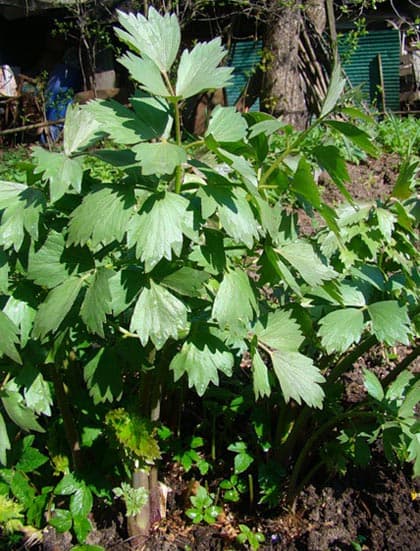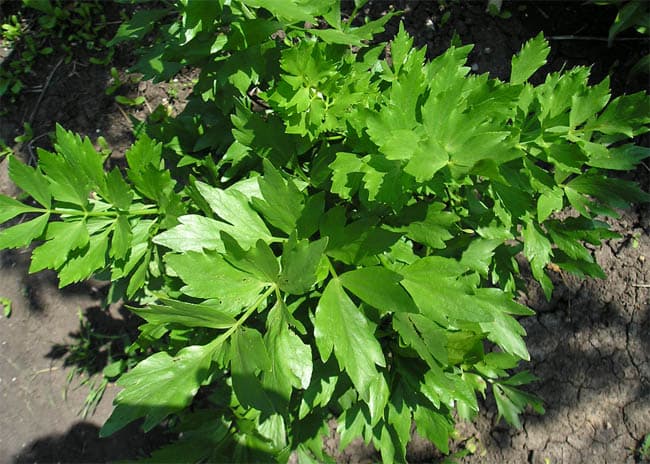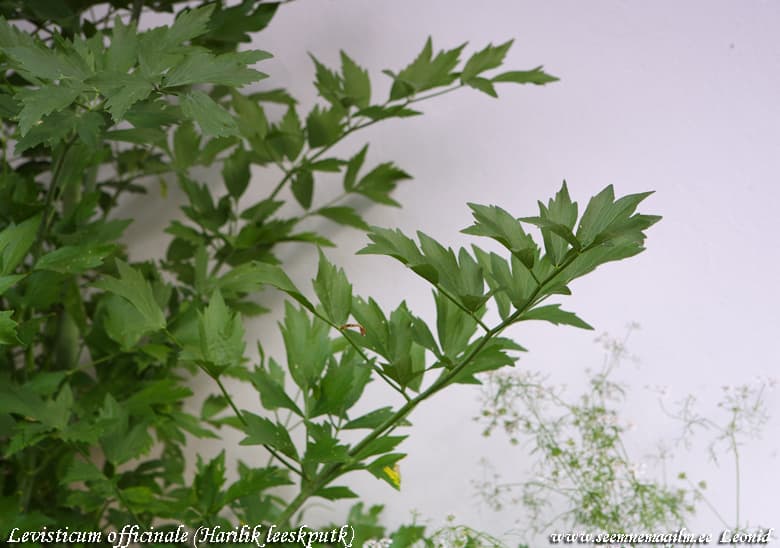Winter hardy and unpretentious. A treasure trove of vitamins and minerals.
"A highlight for the kitchen"!

Perennial growing to 1.8m by 1m . It is hardy to zone 4 and is not frost tender. It is in leaf from March to November, in flower from July to August, and the seeds ripen from August to September. The scented flowers are hermaphrodite (have both male and female organs) and are pollinated by Insects. The plant is self-fertile. It is noted for attracting wildlife. We rate it 3 out of 5 for usefulness. The plant prefers light (sandy), medium (loamy) and heavy (clay) soils. The plant prefers acid, neutral and basic (alkaline) soils. It can grow in semi-shade (light woodland) or no shade. It requires moist soil. Habitats and Possible Locations Woodland, Cultivated Beds, Sunny Edge, Dappled Shade. Edible Uses Condiment; Flowers; Leaves; Root; Seed; Stem; Tea. Leaves and stems - raw or cooked. Used as a savoury flavouring in salads, soups, stews etc, imparting a yeasty/celery flavour. The leaves can be used fresh or dried and are available from late winter until late autumn. To ensure a good supply of the leaves in the summer, it is best to cut the plants down to the ground when flowering in the summer. The young stem can be blanched and used like celery in salads or as a savoury flavouring in cooked foods. Seed - raw or cooked. A strong yeasty flavour, it is used as a flavouring in cakes, soups, salads etc. It can be used whole or ground into a powder. Root - cooked. A strong savoury taste, it can be used as a flavouring[142] or cooked as a vegetable. It is best grated. Best used when 2 - 3 years old. Flowers. No more details are given. A tea is made from the dried leaves. A strong savoury flavour, it tastes more like a broth. A tea can also be made from the grated roots. An essential oil from the root is used commercially as a food flavouring. Yields of 0.5% are obtained. Medicinal Uses Disclaimer Antispasmodic; Aromatic; Carminative; Diaphoretic; Digestive; Diuretic; Emmenagogue; Expectorant; Skin; Stimulant; Stomachic. Lovage is a warming and tonic herb for the digestive and respiratory systems. It is used primarily in the treatment of indigestion, poor appetite, wind, colic and bronchitis. The roots, leaves and fruits are antispasmodic, aromatic, carminative, diaphoretic, digestive, diuretic, mildly expectorant and stimulant. They are used internally in the treatment of disordered stomachs, especially cases of colic and flatulence in children, kidney stones, cystitis, painful menstruation and slow labour. Externally, the root is used in the treatment of sore throats and aphthous ulcers. The roots of plants 3 years old can be harvested in early spring or in the autumn and are used fresh or dried. The leaves are harvested before the plant comes into flower and either distilled for their oil or dried for later use. The leaves, either eaten in salads or dried and infused as a tea, have been used as an emmenagogue. The essential oil from the seeds is used by aromatherapists to remove freckles and spots from the face. Other Uses Essential. An essential oil from the plant is used in perfumery. Cultivation details An easily grown plant, it prefers a rich moist but well-drained soil in a sunny position, though it tolerates some shade. Lovage has very aromatic leaves. It is often grown in the herb garden as a culinary herb and is occasionally grown commercially as a food flavouring. If the plant is cut back to the ground during the growing season it will produce a new flush of young leaves. If the weather is dry at this time, it will be necessary to water the plants in order to encourage fresh growth. Lovage is a good companion plant, improving the health and flavour of other plants growing nearby. The flowers are very attractive to bees and also draw insect predators such as hoverflies into the garden. Propagation Seed - sow spring or early autumn in a cold frame. The seed can be slow to germinate so it is probably best sown as soon as it is ripe. Prick out the seedlings into individual pots when they are large enough to handle and plant them out into their permanent positions in the summer. Division in spring or autumn. This can be quite hard work due to the size of the roots but the plant grows away very well afterwards. Larger clumps can be replanted direct into their permanent positions, though it is best to pot up smaller clumps and grow them on in a cold frame until they are rooting well. Plant them out in the spring.


Eng.: Garden lovage, lovage. Suom.: Liperi, lipstikka, rohtoliperi. Sven.: Libbsticka, libsticka. Bot. syn.: Hipposelinum levisticum L., Levisticum paludapifolium Asch., Ligusticum levisticum L.
* Lovage root is an ancient remedy for the treatment of alcoholism.
To prepare the infusion, 50 g of chopped dry lovage root and 2 bay leaves must be insisted for 15 days in 250 g of vodka.
The alcoholic is then given one glass of this potion to drink. It causes aversion to alcohol, vomiting.
If from a single dose of aversion to alcohol did not come, then the treatment is repeated.












